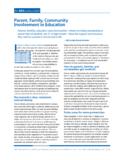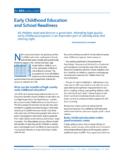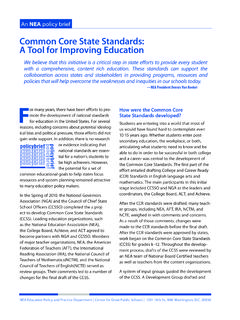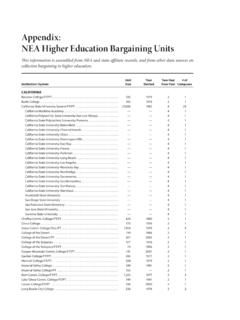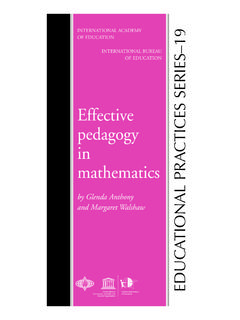Transcription of Family-School-Community Partnerships 2.0 Collaborative ...
1 Priority Schools Campaign Family-School-Community Partnerships Collaborative Strategies to Advance Student Learning National Education Association 1201 16th Street, Washington, 20036-3290. This publication was produced by a team of NEA staff and consultants. Special thanks to all the state and local NEA affiliates for their contributions. Project Manager NEA Interdepartmental Team Roberta E. Hantgan Denise Alston 202-822-7721 Tiffany Cain Dana Dossett Lead Author Jennifer Locke Anne T. Henderson, Senior Consultant to Karen Ohmans the Annenberg Institute for School Reform, and co-author of A New Wave of Evidence: James Sledge The Impact of School, Family, and Community Kathy Tuck Connections on Student Achievement and Brenda Vincent Beyond the Bake Sale: The Essential Guide Brooke Whiting to Family-School Partnerships Cory Wofford Writers and Editors Design Nancy Henderson Kim Hellmuth Cynthia Kain Vanessa Nugent Nancy Kochuk Cindy Long Branding Barbara Moldauer Laila Hirschfeld Carol Sills Strickland Interns Contributors Melissa Malone Dorrie Arrigo Alexandria Richardson Janis Hagey Rita Jaramillo NEA Executive Officers NEA Executive Staff Dennis Van Roekel, President John Stocks, Executive Director Lily Eskelsen, Vice President Sheila Simmons, Director, Becky Pringle, Secretary-Treasurer NEA Priority Schools Campaign Phil McLaurin, Director, External Partnerships and Advocacy Copyright 2011 by the National Education Association.
2 Not for duplication or distribution without express written permission from the National Education Association. All rights reserved. The National Education Association is the nation's largest professional employee organization, representing million elementary and secondary school teachers, higher education faculty, education support professionals, school administrators, retired educators, and students preparing to become teachers. Family-School-Community Partnerships Foreword Jennifer Pasillas. Henrietta Parker. Sarah Gebre. Bryan Sanguinito. Paty Holt. Rhonda Johnson. Their names may not be familiar now. But if their recent work is any indication, they will be soon. They are just a few of the amazing educators, parents, and Association and community leaders featured in Family-School-Community Partnerships : Collaborative Strategies to Advance Student Learning. NEA's core belief is that all students deserve great public schools. And these dedicated individuals embody the spirit of partnership and collaboration between educators, parents, and community leaders that is critical to student success.
3 Family-School-Community Partnerships outlines 10 strategies that are the foundation for creating effective Partnerships , like building one-to-one relationships between families and teachers that are linked to learning. That tactic was the key to success for the Parent-Teacher Home Visit Project in Sacramento, which is now being replicated in school districts across the country with support from NEA. The program grew out of a desire to disrupt the cycle of blame between families and schools, and it is now recognized as a national model. One of this report's greatest values is its portrayal of the broad range of school personnel involved in these efforts from school bus drivers and teachers, to administrators and cafeteria workers. Regardless of job category, educators are helping create and sustain essential Partnerships with their communities. The examples in Family-School-Community Partnerships are impressive, and we know there are many, many more to be found.
4 NEA will continue to collect, disseminate, and elevate such examples because we believe families, schools, and communities are fundamentally and positively interconnected. This guide will also be an important resource for the educators, community members, and parents who have joined NEA's Priority Schools Campaign in 39 of the nation's most under-resourced, underfunded schools. They are currently examining these strategies with an eye toward sparking new thinking about what's possible in their own communities. Finally, we commend our allies who share our vision of collaboration: the Annenberg Institute for School Reform, the Coalition for Community Schools, the Harvard Family Research Project, Communities In Schools, the National PTA, and the National Network for Partnership Schools, whose programs in the field of Family-School-Community Partnerships continue to contribute to our efforts. Thank you for joining with us to improve the odds for our nation's students.
5 Dennis Van Roekel, President National Education Association Family-School-Community Family-School-Community Partnerships Partnerships Table of contents Name of program School or District Location Type of program Page Community and Family-Community Programs Making Parents James A. Shanks Quincy, Florida ` Family-Community Count Middle School ` School 25. ` Established Wicomico Wicomico County Salisbury, Maryland ` Community Mentoring Project Public Schools ` Countywide 29. ` Mature Bringing Learning Columbus City Columbus, Ohio ` Community to Life Schools ` Districtwide 33. ` Emerging Programs to Engage Parents and Other Family Members Academic Parent- Creighton Phoenix, Arizona ` Parent/Family Teacher Teams Elementary School ` Districtwide 37. District ` Established Parent-Teacher Sacramento City Sacramento, ` Parent/Family Home Visit Project Unified School California ` Districtwide 41. District ` Mature Revitalizing the Geraldine Bridgeport, ` Parent/Family Title I School-Parent W.
6 Johnson Connecticut ` Districtwide 45. Compact Elementary-Middle ` Emerging School Climate and Culture Math and Science Denver, Colorado ` Parent/Family Committee Leadership ` School 49. Academy ` Emerging Hispanic Parents Capt. James E. Germantown, ` Parent/Family Council Daly Jr. Elementary Maryland ` School 53. School ` Established Infinite Campus Washoe County Reno, Nevada ` Parent/Family Parent Portal, Ninth School District ` Districtwide 57. Grade Outreach ` Emerging Program Before- and After- Elmont Memorial Elmont, New York ` Parent/Family school Support Junior-Senior High ` School 61. Programs School ` Established O VE. TA BLRVI. E OF. E WC ONT ENTS NEA PRIORITY SCHOOLS CAMPAIGN 2. Family-School-Community Partnerships Name of program School or District Location Type of program Page Programs to Engage Parents and Other Family Members Compadres in Putnam City West Oklahoma City, ` Parent/Family Education High School Oklahoma ` School 65.
7 ` Established Successful Upper Merion Area King of Prussia, ` Parent/Family Transitions Middle School Pennsylvania ` School 69. ` Mature Parent and Reading School Reading, ` Parent/Family Community District Pennsylvania ` Districtwide 73. Outreach Initiative ` Emerging Wraparound Social and Community Services Programs Community-School Evansville Evansville, Indiana ` Wraparound Programs Vanderburgh School ` Districtwide Corporation ` Mature 77. Lincoln Community Lincoln Public Lincoln, Nebraska ` Wraparound Learning Centers Schools ` Districtwide ` Mature 81. SUN Service System 8 school districts in Portland, Oregon ` Wraparound Multnomah County ` Countywide ` Mature 85. O VE. TA BLRVI. E OF. E WC ONT ENTS NEA. NEA P RIPRIORITY. O RI TY SC SCHOOLS. H O O L S CACAMPAIGN. M PA IG N 3. Family-School-Community Partnerships to Advance Student Learning Executive Summary In local communities across the country, NEA affiliate Educators and leaders who are active members in `.
8 Members and leaders are working closely with NEA local and/or state affiliates parents, families,* and community members to close A two- to five-year track record ` . achievement gaps, improve low-performing schools, and transform relationships between schools and their Success in engaging families and/or community ` . communities. organizations This report identifies and describes key Partnerships Evaluation plans in place to measure student ` . that Association members have forged in 16 outcomes communities and includes the Association perspective Increased family or community involvement over ` . on these efforts. time Part I of this report reviews recent research on Reasonable costs and potential for others to ` . school and family collaboration and presents replicate the program 10 key strategies for creating effective family- school-community Partnerships that are focused Three Types of Initiatives on advancing student learning. It also includes The 16 programs profiled in this report fall into one of recommendations for moving this important work three categories: forward.
9 ` . Community and family-community programs: Part II contains profiles for each of the 16 partnership These are efforts to engage the community programs. In many cases, Association members (including families, local residents, and community have been catalysts for or taken on key roles in these organizations) in advancing student learning. effective programs. These profiles demonstrate very clearly that Family-School-Community Partnerships ` . Programs to engage parents and other family with a central focus on advancing student learning members: These are programs/efforts to engage can have a powerful impact. families in children's learning and development. ` . Wraparound social and community services Methods programs: These are programs that provide social To learn more about local Family-School-Community and health services to strengthen and support Partnerships , an interdepartmental NEA work group children and families. reviewed a host of parent and community engagement initiatives designed to advance student learning in schools and districts represented by NEA's local and state affiliates.
10 In this first scan, the team identified 16. Partnerships that meet the following criteria: * Throughout this report, we define parents and families to mean any family members, legal guardians, or other adults acting in a parental role to a student. NEA PRIORITY SCHOOLS CAMPAIGN 4. Family-School-Community Partnerships Ten Key Strategies for Effective Partnerships Across these programs, the NEA team identified 10 major Strategy #6 - Using targeted outreach to focus on high- strategies and approaches that define the direction of needs communities, schools, and students: Identifying program efforts and appear to be critical to their success. groups that need special attention, learning about Strategy #1 - Agreeing on core values: Taking time their concerns and needs, and responding in culturally at the beginning to think deeply and reflect about what appropriate ways. participants believe, and why they think the efforts will work. Strategy #7 - Building one-to-one relationships between Strategy #2 - Listening to the community: Identifying families and educators that are linked to learning: priorities and developing an action plan in a Collaborative Taking time to have conversations and reach agreement way that creates community consensus around what on how best to collaborate in order to improve student needs to happen and in what sequence.

